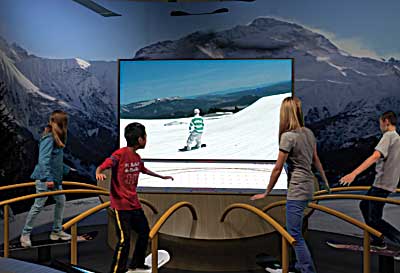“MathAlive!” + Smithsonian = Fun!
It is the age-old question every student asks: “When will I ever use this math in real life?” While it may seem that long division and pi are not applicable to life outside of the classroom, visitors to “MathAlive!” will learn exactly the opposite—math is actually a big part of all the things they love. Launching its national tour at the Smithsonian’s S. Dillon Ripley Center March 10, the exhibit will use interactive stations and immersive environments to demonstrate that math is involved in nearly every action every day. The exhibition is sponsored by Raytheon Co.
Visitors will have the opportunity to learn how math is not just in a classroom or in front of a computer. Escorted by three robots—the BotZ Squad—visitors will experience math in new ways through six themed galleries.
In “Outdoor Action,” students will participate in various activities that demonstrate math’s presence in their favorite sports. Kids can design skateboards to see how length, angles, shape and wheel size and position determine speed and capability. Visitors can also practice snowboarding skills using body torque and angles of the board to increase speed and accuracy, while racing down a virtual hill.
“Build Your World” explores the use of math in the environment. Activities include planning a day at the beach and learning about city infrastructure in order to design an efficient and energy-conscious environment. Another interactive station demonstrates how scientists use math when testing river-water safety for use in daily life. Faced with the problem of limited power supply in an emergency situation, visitors will solve the equation by choosing which services need to continue while staying within the power limit.
In “Future Style,” kids can combine the creativity of design and patterns from the natural world with the facts of mathematics. Visitors can step onto a photo stage, pose and have the image captured in 360 degrees, using the same freeze-motion technique made famous in contemporary action movies. Students can create a kaleidoscope using shapes and an infinity mirror that form perfectly congruent tiles with no overlap.
The “Entertainment” gallery brings together some favorite pastimes—music, movies and dance. Visitors will add and subtract musical instruments to create a one-of-a-kind soundtrack and silhouettes of dance enthusiasts will be reflected in rainbows and fractals. The “Game Plan” gallery allows visitors to design video game objects at touch-screen workstations. Using computer-aided design, the objects will be launched into the game to see how specifics of the design effect its survival in the game. Other interactive games, such as Crack the Code, Flip It and Game Box Kids demonstrate the importance of math in game design and implementation.
The final section of the exhibition, “Robotics/Space,” gives kids the opportunity to be a NASA scientist and program a Curiosity Rover over the Martian landscape on a giant tabletop screen. Visitors can also control a robotic arm on a scaled model of the International Space Station and explore star fields using images taken by the Hubble Telescope.
The “MathAlive!” exhibition also will feature a small store. Visitors can purchase an array of math-related items, such as books, robots, jewelry, t-shirts and games.
“MathAlive!” will be on exhibition from March 10 to June 3 in the S. Dillon Ripley Center’s International Gallery at 1100 Jefferson Drive, S.W.
# # #
SI-98-2012

